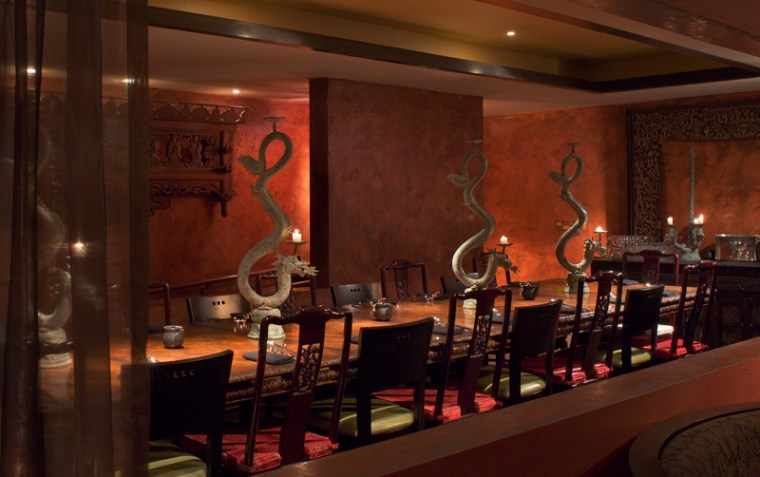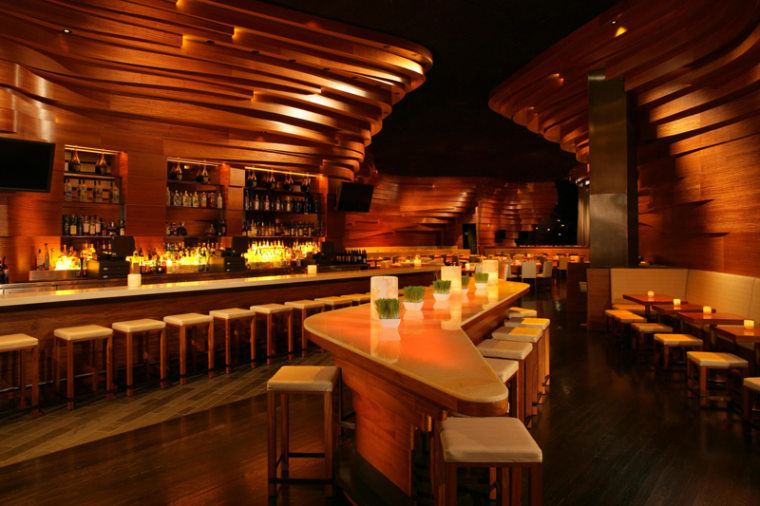Architect Adam Tihany was once again staring at the empty space. Plans called for a simple metal staircase to lead diners into a sunken restaurant in the soon-to-open Mandalay Bay, but it just didn’t sit right with him.
“There are already too many metal staircases in this city,” he told Bill Richardson, then vice chair of Mandalay Resort Group. “You’re sure there’s nothing else we can do?” Richardson, unconvinced, gave the architect until the following morning to present a better idea.
The next day, inspired by a late-night showing of Tom Cruise’s “Mission: Impossible,” Tihany made Las Vegas restaurant history. His four-story glass wine tower at the center of Aureole Restaurant would be accessed by high-wire “wine angels,” who would zip up and down the tower to retrieve bottles for the diners below.
The logic that “this just might be crazy enough to work!” has been integral to transforming the blank canvas of Las Vegas into a world-class destination of uniquely designed restaurants. Tihany’s $1.2 million tower went on to generate millions in free publicity, drawing thousands of spectators to the balcony overlooking the restaurant and helping to make the restaurant one of the biggest-selling wine destinations in the fine dining universe.
In recent years, as construction of new mega resort-casinos has slowed, the one-upmanship race on The Strip has turned to who will build the next more ambitious, more outrageous, more fantasy-fuelled place to eat.
“We do have very, very generous budgets because of the economic basis for our business,” says Todd Avery Lenehan, designer of three Wolfgang Puck restaurants on the Strip, “and we also have the luxury of real estate and space.” In other major markets, such as Los Angeles in New York City, real estate comes at a premium. “In Las Vegas, you have big column-free spaces.”
The emphasis on design marks a major sea change in a city once known as a culinary wasteland of standardized steak joints, dark rooms and sloppy buffets. Increasingly, it’s known as a modern paradise for ambitious designers who want dinner time to be as entertaining as the stage shows. Nowadays, the Bellagio has paintings by Picasso hanging in a restaurant named for the artist; in the soon-to-open Encore resort, a restaurant called Botero will be adorned by the sculpture of — you guessed it — Ferdinand Botero.
“A lot of designers of my generation looked at the restaurants that were here and thought, ‘How boring,’” says Roger Thomas, Steve Wynn’s interior designer for a quarter century and the one responsible for the “Hello, Dolly”-esque staircase entrance at Alex at Wynn Las Vegas. “We saw the prospects for decor as entertainment, for decor as marketing. You used to very seldom see a picture of a restaurant room in an advertisement. But we’ve made it so that that element is used as a competitive angle.”

In Vegas, it’s not enough to merely become one of the great dining destinations in the world. Chefs who once thought it unthinkable a decade ago to even consider cracking an egg on the blistering Sin City sidewalk are now clamoring to build that mind-blowing something.
“Las Vegas is a great experimental design laboratory, one of the few places in the world where the clients are very receptive and open to new ideas and new concepts,” says Tihany, who designed Circo at the Bellagio as well as the buffet Cravings at The Mirage. “It’s a very unique place where people appreciate what a big role design plays in making fantasy happen. They’re willing to pay for the added value of something that’s innovative and over the top.”
Even the buffets are being made over. Lenahan insisted on having an overhead skylight at the Wynn Las Vegas buffet to allow natural light and decorated the dining areas with flowers and massive fruit-laden topiaries to “put forth a sense of wholesomeness, quality, real ingredients and a sense of wellness that comes from the Earth. That skylight was an architectural extravagance but I thought it was critical.”
Many results astound. The top-floor view down The Strip apparently wasn’t enough of a stunner or conversation piece for Alain Ducasse’s Mix at THEHotel at Mandalay, so they tossed in that $500,000 chandelier with 13,000 pieces of blown glass to envelop indoor diners. At the MGM Grand, the much-admired $6 million Japanese hotspot Shibuya greets guests with a 50-foot video wall behind the main bar as well as tables partitioned by striking floor-to-ceiling bamboo for a forest-like effect. Even the understated elegance of Fleur de Lys at Mandalay Bay has its design treasure: a leaf-shaped wall installation crammed with more than 3,500 fresh pink roses that accent colors in the restaurant’s china.
“There are budgets in Las Vegas — it’s not a blank check. But on the other hand, if there’s an idea that’s over the top and unbelievable, you have a real opportunity to sell it,” says Jeffrey Beers, who designed Rumjungle, Red White and Blue and China Grill at Mandalay Bay as well as Daniel Boulud Brasserie at Wynn. “If it’s great, somebody will fund it.”
To wit, what Vegas offers these chefs is the chance to build that restaurant of their dreams, the one they never could have conceived of when they were financing their original ventures by mortgaging their homes. The arrangements vary depending on the property — MGM Mirage and Wynn own and build most of their restaurants, whereas the Venetian leases the space — but by and large the results are the bigger, bolder, more ambitious realizations that chefs could only fantasize about earlier in their careers.
“Very, very few independent restaurateurs could ever afford something of this level of quality, scope and design,” says Paul Bartolotta, whose $10 million Ristorante Bartolotta di Mare includes mammoth terracotta jugs and crystal chandeliers that hang down the center of a curved staircase heading to a dining room that offers outdoor seating next to waterfalls and a koi-filled lake. “Nobody could afford the level of drama you have here if it weren’t a part of something like this resort.”
That’s not to say it always works. At Wynn, the Mediterranean Italian eatery Corsa Cucina by chef Stephen Kalt saw underwhelming traffic when it opened in 2005. Thomas and Wynn decided the place was too closed off and dark, and by year’s end walls were knocked down to open the bar area up to the casino.

Since many of these restaurants are Vegas versions of eateries from elsewhere, there’s always a debate about whether to try to recreate the original with some Vegas touches or to go in a totally different direction. Craftsteak at MGM Grand, for instance, recreates the look of Craft in New York with the steel-mesh separating the booths and the naked light bulbs hanging in rows in the main dining room. Aureole, though, bears no resemblance to its namesake in New York.
Most are hybrids. Tao Asian Bistro, a 42,000-square-foot restaurant-nightclub-lounge, is one such example. The original Tao on East 58th Street in Manhattan was a quarter of the size and doesn’t have a nightclub, but some of the key design features — a 20-foot-tall Buddha as a centerpiece and a worn-looking brick wall — are meant to evoke facets of the New York original. Yet even in some of those details, there’s a Vegasizing aspect; the Vegas Buddha, Tao owner Richard Wolf says, “is sexier, the waist a little curvier.”
“This is the project of our lifetime,” Wolf says of the $20 million venture, mimicking a sentiment commonly heard from other restaurateurs these days. “It’s the biggest, most challenging restaurant we’ve ever done. To build in Las Vegas, where anything is possible — that is the highlight.”
